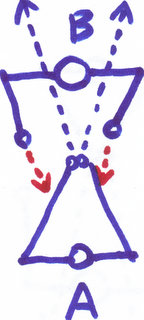Here is the pressure test for "using rhino guard to obtain clinch - change a striking game into a wrestling game".
Your opinion are welcome.
Your opinion are welcome.
Follow along with the video below to see how to install our site as a web app on your home screen.
Note: This feature may not be available in some browsers.
1. What is the benefit of having your hands together instead of apart?
2. What is the benefit of having your hands way in front of you when trying to close the distance, as opposed to closer to your body?
I'll call that "double spears" strategy or "Chinese zombie arms" strategy. It's on the same level of the "rhino guard" strategy. It will be used to achieve lower body control clinch (by downward separate hands) such asif your hands are apart, it allows you better coverage on incoming strikes,
You close your front door. Only allow your opponent's to punch through your side doors. This can disable your opponent's jab and cross. You encourage your opponent to use hook punch. You also hide your head behind your arms.
To fight in your opponent's territory instead to fight in your own territory. This will disable your opponent's uppercut. If your opponent's bending arm uppercut can hit your chin, your fists should be able to hit his face too.
The rhino guard has not been tested in the kicking environment yet. It will be tested in the next 3 months.If you've got your head buried in that guard, you're putting yourself at the perfect spot for a front snap kick to the nose.
This is why you want to move your hands as close to your opponent's head as possible. Of course you may have to sacrifice some of your punching ability.If you're going for a headlock or overhook, you want to be in his territory.
I don't mind to pay some extract price to protect my head from punched.It seems a very high risk guard position for very little gain, in my opinion.
This is why you want to move your hands as close to your opponent's head as possible. Of course you may have to sacrifice some of your punching ability.
I don't mind to pay some extract price to protect my head from punched.
You are right. The original intention was not to use rhino guard to chase my opponent away. The original intention was when my opponent moves in, I move in at the same time, I then use my arms to drill a hole between his arms.What I'm saying is, in order to make the headlock work, you have to be in close. But the guard is meant to keep him away. These seem like conflicting goals to me.

The rhino guard has not been tested in the kicking environment yet. It will be tested in the next 3 months.
This is why you want to move your hands as close to your opponent's head as possible. Of course you may have to sacrifice some of your punching ability.
I don't mind to pay some extract price to protect my head from punched.
You are right. The original intention was not to use rhino guard to chase my opponent away. The original intention was when my opponent moves in, I move in at the same time, I then use my arms to drill a hole between his arms.

Well maybe, and maybe not. There are all kinds of things that work quite well, that are not found in a combat sport venue. Not everything has a place in every venue. Some things are not appropriate in a particular venue, or they don’t have a need for it because they use other things that also work.Good on you for thinking outside of the box, but at the same time, if this tactic worked, we'd likely see it in some sort of combat sport already.
You are right. The original intention was not to use rhino guard to chase my opponent away. The original intention was when my opponent moves in, I move in at the same time, I then use my arms to drill a hole between his arms.

You look very vulnerable to a push kick or mid-level roundhouse, and your head looks vulnerable to a hook punch or ridgehand if your opponent steps off the line instead of retreating straight back.
Good on you for thinking outside of the box, but at the same time, if this tactic worked, we'd likely see it in some sort of combat sport already.
I would need to see it applied when there is kicking involve. For me, I would probably punch the arms. I tend to take what my opponent is willing to give. So in this scenario, I would attack the arms literally punching them for the purpose of making the less efficient.
I'm happy not to punch at the face if you are willing to give me something else to punch at.
The video looks like you were testing it against one type of an attack.
Can you elaborate on what you mean here? I agree that the hip throws, sweeps and sacrifice throws are readily available. But, the wrist locks will be next to impossible to get since the hands are together, supporting each other. The elbow locks look inviting... but again, since the hands are together, if there is even a slight bend in his elbows, the elbow locks will be very hard to get. Was there some other direction you were going?If someone wants to give me their hands and keep the rest of their body away, an experienced Hapkidoist would have a field day.
